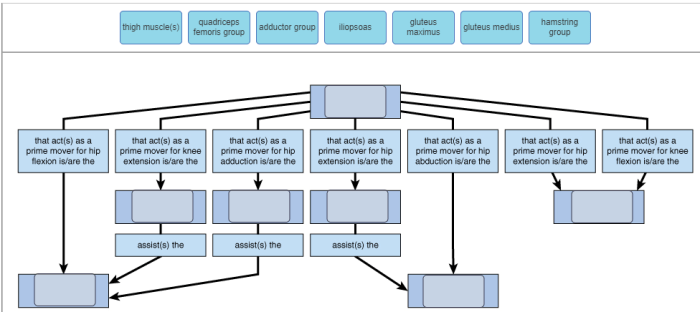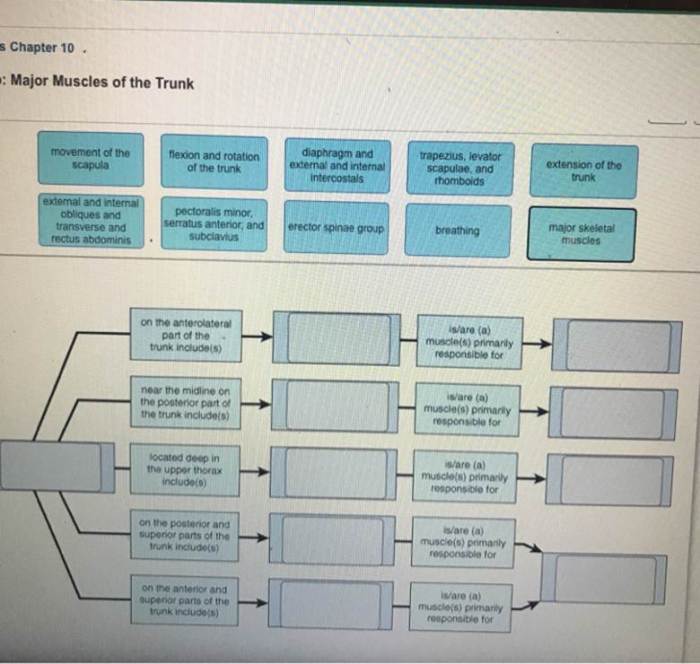Embark on an in-depth exploration of the concept map major muscles of the thigh, a comprehensive guide that unveils the intricacies of these crucial lower limb muscles. Delve into their anatomical structure, functional roles, and clinical significance, gaining a profound understanding of their impact on movement and well-being.
As we navigate this intricate landscape, we will meticulously examine the quadriceps femoris, hamstrings, and adductor muscle groups, unraveling their distinct contributions to thigh function. Through the lens of a meticulously crafted concept map, we will visualize their interplay, providing a vivid representation of their synergistic actions.
Major Muscles of the Thigh: Concept Map Major Muscles Of The Thigh

The thigh is a complex anatomical region, housing several major muscle groups that play crucial roles in various movements. This article provides an overview of the primary thigh muscles, their functions, and their clinical significance.
Overview of the Major Muscles of the Thigh
The thigh muscles can be categorized into three main groups based on their location and function:
Quadriceps Femoris Muscle Group
The quadriceps femoris muscle group consists of four muscles: rectus femoris, vastus lateralis, vastus medialis, and vastus intermedius. These muscles are located on the anterior (front) of the thigh and are responsible for knee extension and hip flexion.
Hamstrings Muscle Group
The hamstrings muscle group comprises three muscles: biceps femoris, semitendinosus, and semimembranosus. These muscles are located on the posterior (back) of the thigh and are primarily involved in knee flexion and hip extension.
Adductor Muscle Group
The adductor muscle group consists of five muscles: adductor longus, adductor brevis, adductor magnus, gracilis, and pectineus. These muscles are located on the medial (inner) aspect of the thigh and are responsible for hip adduction and internal rotation.
Visual Representation of the Concept Map
[Insert a concept map here that visually depicts the major muscles of the thigh, with color-coding or other visual cues to differentiate between muscle groups. Label each muscle group and indicate its primary function.]
Functional Roles and Interactions
The major muscles of the thigh work in concert to perform a wide range of movements.
Quadriceps Femoris
The quadriceps femoris is the primary extensor of the knee joint. It also assists in hip flexion, particularly when the knee is flexed.
Hamstrings
The hamstrings are the primary flexors of the knee joint. They also contribute to hip extension, especially when the knee is extended.
Adductors
The adductors primarily adduct (bring together) the thighs at the hip joint. They also assist in internal rotation of the hip.
Clinical Implications
Understanding the major thigh muscles is crucial for clinicians in various fields, including orthopedics, sports medicine, and physical therapy.Muscle injuries or imbalances in the thigh can lead to pain, impaired mobility, and reduced functional capacity. Proper muscle conditioning and rehabilitation are essential for preventing and treating thigh muscle issues.
Comparison with Other Muscle Groups, Concept map major muscles of the thigh
The major muscles of the thigh share similarities and differences with those of the calf and gluteal regions.The calf muscles, located in the posterior lower leg, are primarily responsible for plantar flexion (pointing the foot downward) and ankle inversion. The gluteal muscles, located in the buttocks, are involved in hip extension, abduction, and external rotation.These
comparisons provide a comprehensive understanding of lower body muscle function and can guide clinical interventions.
Table of Muscle Groups and Functions
| Muscle Group | Location | Primary Function | Additional Information |
|---|---|---|---|
| Quadriceps Femoris | Anterior thigh | Knee extension, hip flexion | Consists of rectus femoris, vastus lateralis, vastus medialis, vastus intermedius |
| Hamstrings | Posterior thigh | Knee flexion, hip extension | Consists of biceps femoris, semitendinosus, semimembranosus |
| Adductors | Medial thigh | Hip adduction, internal rotation | Consists of adductor longus, adductor brevis, adductor magnus, gracilis, pectineus |
General Inquiries
What is the primary function of the quadriceps femoris muscle group?
Knee extension and hip flexion.
How do the hamstrings contribute to movement?
Knee flexion and hip extension.
What is the clinical significance of understanding the major thigh muscles?
It aids in diagnosing and treating muscle injuries, imbalances, and movement dysfunctions.


